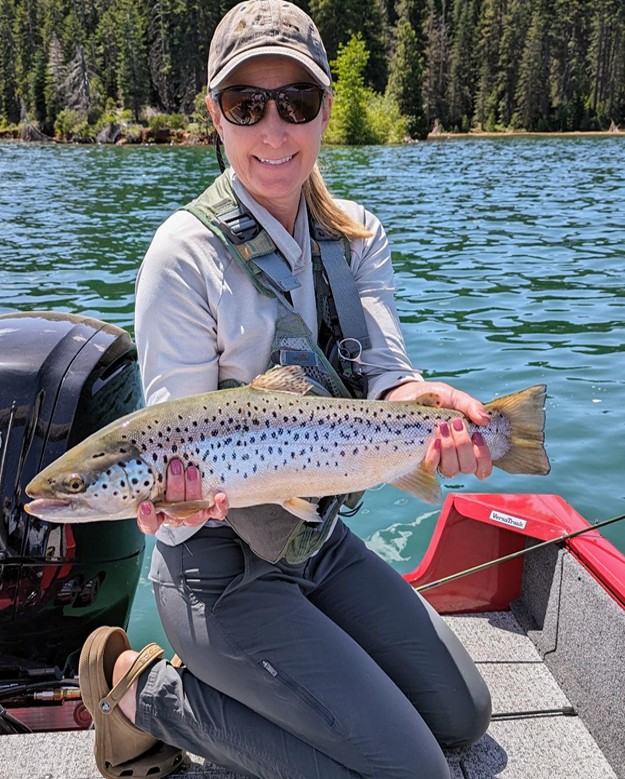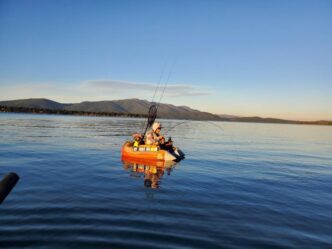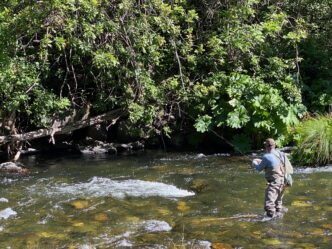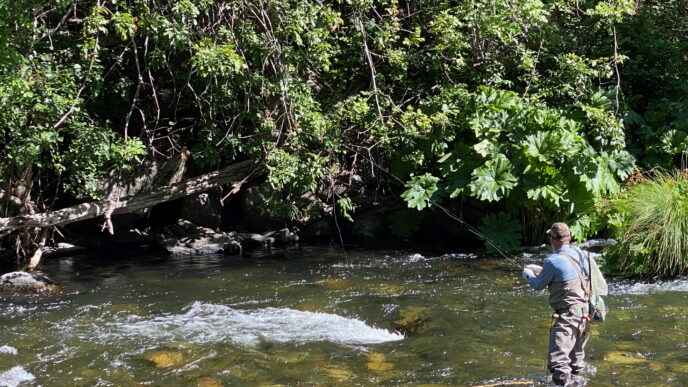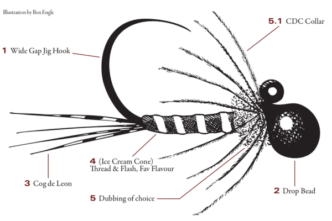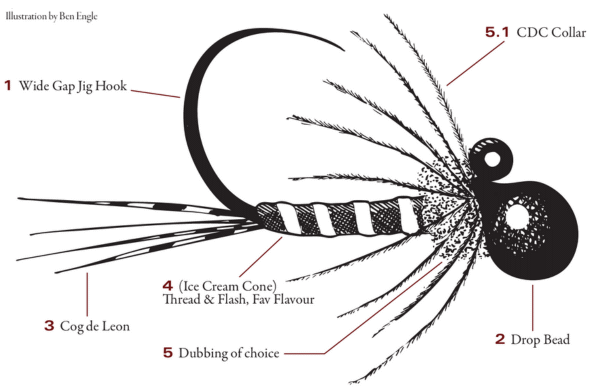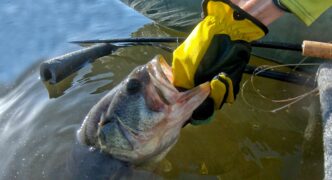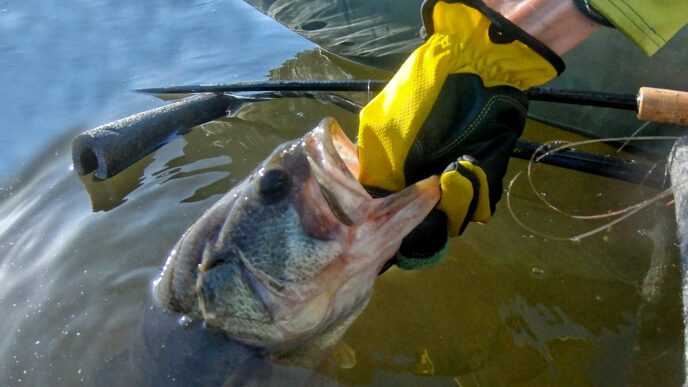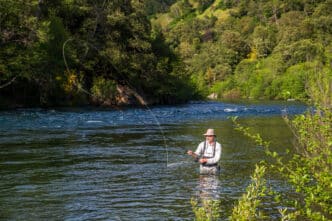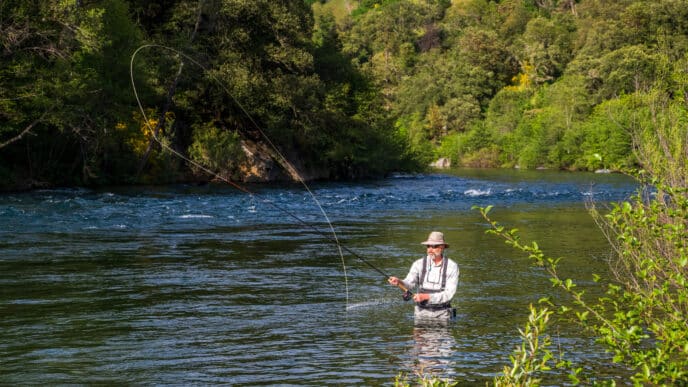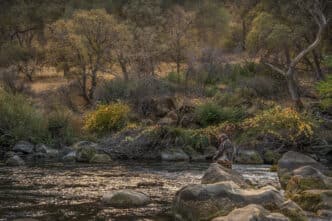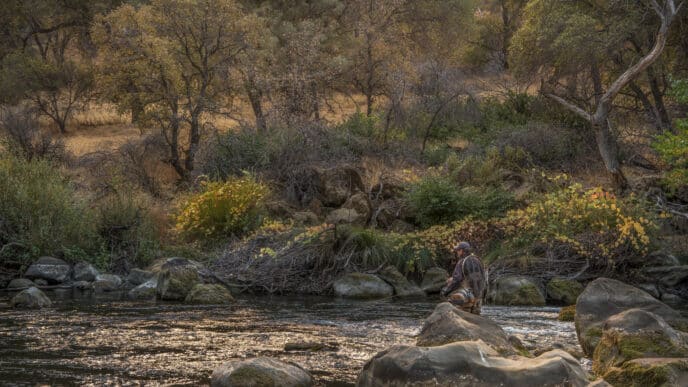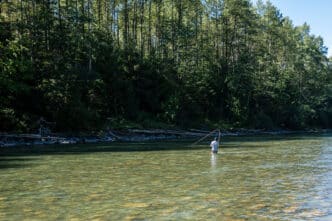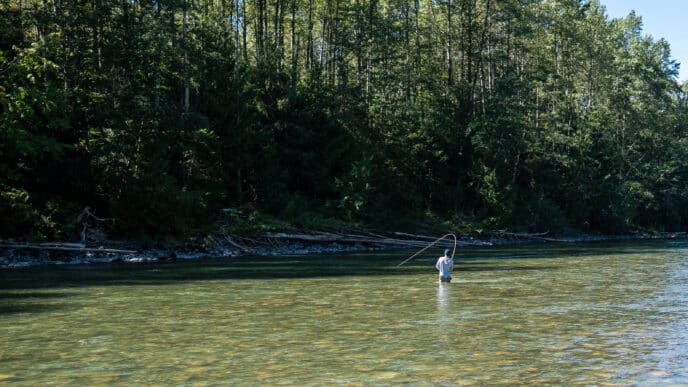Many decades ago, using an indicator in deep water was unheard of in most fly-fishing situations. The standard approach was to fish sinking lines to get the fly down to the fish, or wait until fish were closer to the surface. But today, deepwater indicator tactics open up a whole new world for stillwater anglers.
I’d been using an indicator system on valley rivers and stillwater for a while, but they weren’t built for depth. This deepwater setup I’ll describe allows you to fish effectively at depths of 25 feet—or even more. When developing this system, I created numerous prototypes using various materials, indicators, and configurations. I asked for help from other fly-fishing gurus and even hired guides just to observe their approaches. Asking questions shortens the learning curve, and I hope this article does the same for you.
THE BEGINNING
When I first started using indicators, I relied on corkies and tapered leaders, fishing two to three feet deep with mayfly imitations—often using a Stillwater Bird’s Nest by Milt Jensen that he designed for Butt Valley Reservoir. Later, when I started fishing and guiding rivers, I used poly yarn indicators attached by a loop-to-loop connection to tapered leaders. Both were adequate for what they were designed to do, but I kept looking for something better, especially for stillwater.
My river indicator system developed faster than the stillwater. I designed the river system for use on a drop leader. A drop leader is just that—a leader that is designed to drop your flies to a certain depth. It’s typically not a tapered leader; instead, it’s made from heavy material, like 20-pound fluorocarbon. I attach a barrel swivel at each end of the 8-foot section: one swivel is tied to the fly line using a 40-pound monofilament “cheater” (looped to the line and tied to the swivel), and the other swivel connects to the tippet. This setup lets me swap out tippet weights easily and roll up the leader when I’m done, ready for the next fishing trip. On the 20-pound fluorocarbon drop leader, I use three bobber stoppers on each side of my Gray’s Indicator. These stoppers will hold the indicator in the desired position on the drop leader and allow for adjusting the fly depth by sliding the stoppers up or down. Since bobber stoppers use friction to grip, they heat up during adjustment. Fluorocarbon handles this better than mono—it won’t curl up on you.
THE ‘AHA’ MOMENT
Since this system worked so well on rivers, I tried it on stillwaters. It worked great—but only reached about 12-13 feet deep. Way too deep to land fish, especially in a boat. You could bank the fish if you were onshore, but that’s not great for fish health.
I adapted the system by using a pop-off indicator with the same basic leader structure and weight placed above the terminal barrel swivel to help the drop leader sink vertically. This system performed well when using stronger tippet (2X-4X), but its effectiveness decreased with lighter tippet material (5X-7X). The pop-off indicator would create such a great pop (snag and then give) that it would break the small tippet. I got very frustrated with it, especially while fishing Manzanita Lake.
Then came the breakthrough. While rigging up at Lake Almanor, I was explaining the pop-off system to my dad when he remarked, “Violent, isn’t it?” The next day, I was setting up my river indicator system to fish midges at Manzanita Lake and forgot to place bobber stoppers on one side of the indicator. When I went to rig my fly rod with it, the indicator slid back and forth on the 20-pound drop leader. I screamed some profanities, sat down on the picnic bench, and realized I was on to something.
I jumped up and tied a 20-foot drop leader, with only one set of bobber stoppers, above the indicator, toward the fly line. This allowed the leader to sink while the indicator slid down until it hit the upper stoppers. Moving those stoppers lets me fine-tune depth. It was a magic moment. I fished Manzanita Lake the next day with 6X tippet and had no issues breaking off fish due to tippet failure caused by the indicator, and I could raise or lower the flies by moving the bobber stoppers up and down. I was brilliant!
SYSTEM UPDATES
Today, my “Deepwater Leader” is built mostly the same, with a few tweaks:
- I use only one bobber stopper, positioned above the indicator towards the fly line barrel swivel.
- I use red bobber stoppers instead of black (easier to see in low light).
- A tungsten weight (SSG size) sits above the terminal swivel to help the leader sink vertically.
- I tie on 4–5 feet of tippet to get my terminal fly down to 25 feet.
- My flies are weighted—jig-style, balanced, or midges with tungsten beads or lead heads.
The heavier you go, the more you must consider your indicator’s buoyancy. More weight requires more buoyancy. My Gray’s Indicator holds about 1/8 ounce of weight. Always test your indicator with your chosen flies and weights before fishing.
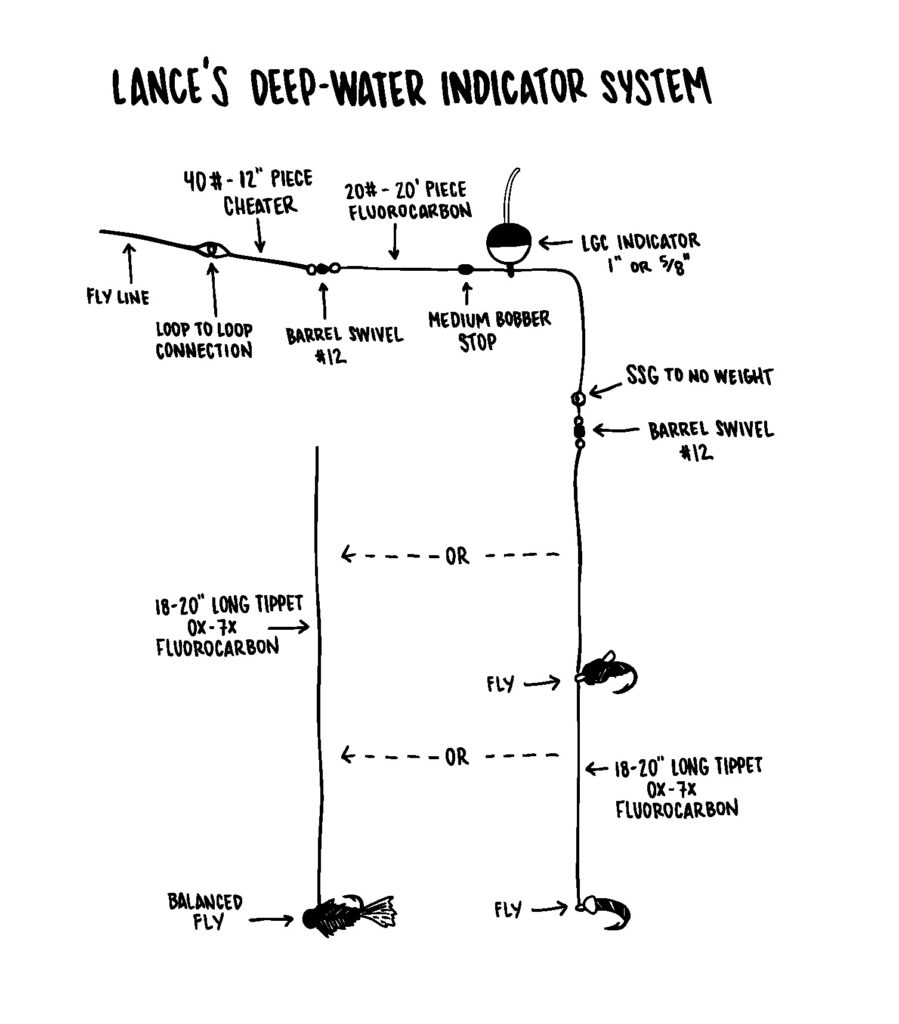
DROPPING VS. CASTING
I typically drop this rig rather than cast it. If you’re in a kayak or float tube, start with the fly and weight, let the leader sink, then place the indicator on the water. Think of it like soaking a crab pot. Remember, at twenty-five feet deep, you are approximately two and a half to three stories above the fly. Having your rod tip directly over this system about six to twelve inches above the indicator is a huge benefit. It allows you to set the hook quickly and maximize leverage.
You can cast this setup. The 20-pound fluorocarbon is stiff enough to cast efficiently. Use a water-load cast—cast the line to the rear of you and use the water to load your rod by dragging the line and leader along the water to make your forward cast. The indicator will slide down to the terminal barrel swivel, allowing you to cast all your line and indicator simultaneously. Afterward, you’ll need to feed the line to the indicator using mends. This keeps the indicator from coming right to you. Remember, the further your fly is from your rod tip, the more slack you must manage when a fish hits. Keep your line tight or you’ll lose all your leverage.
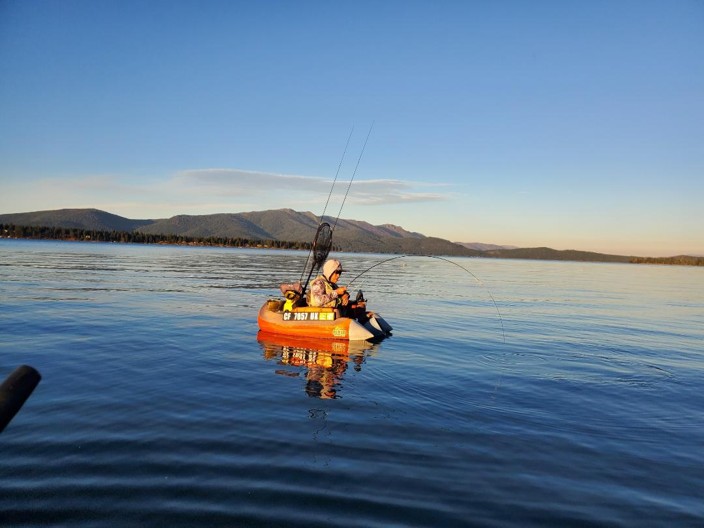
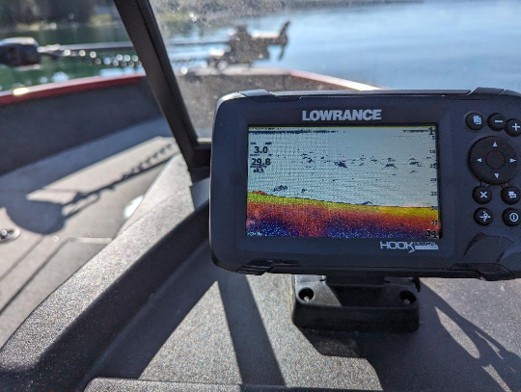
FISHING & TIPS
This deepwater indicator system works from five to 25 feet deep, depending on where you place the bobber stopper.
It is essential to know the entomology of what you are trying to imitate, including where they live and how they hatch. Midges live in mud. When they start to hatch, they leave their mud tubes by blowing a small gas bubble and floating to the surface. Once at the surface, they hatch from their exoskeletons into adults in a matter of seconds. Minnows hang around structures for safety, although some are found in deep water in bait balls. Weed beds, rocks, and logs will all hold different minnow species. Use a fish finder to read bottom structure, determine depth, and locate fish in the water column. Adjust your indicator to position your flies to match their depth.
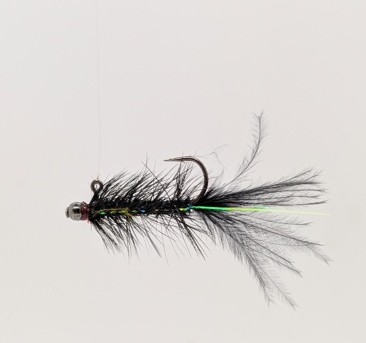
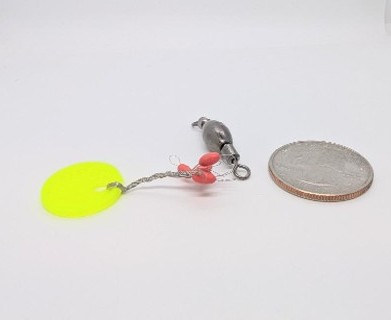
When fishing midges, I stack them by color and depth on the tippet. I use red and black midges on days with less sun or deep water (15-25 feet). On lighter days or in shallow water (10-15 feet), I will fish with gray, red, and black midges, with gray-colored midges tied higher up on the tippet to reflect light and give the fish a more apparent silhouette.
With jig, balanced, lead-head flies, I fish one fly at a time. I use the same color choice as I do with midges. I prefer not to use a loop knot for these flies. Many fly fishers may be puzzled by this, but I like using a standard terminal knot. This lets me adjust how the fly sits in the water. Tightening the knot can level a poorly tied balanced fly or position a pattern like Gray’s Balanced Hex at an upward 30° angle—mimicking the natural swim of Hexagenia nymphs.
Water surface movement is key to working both midges, balanced jigs, or lead-head flies. Waves give your flies animation in the water. Gentle waves give your flies subtle action. Larger waves give you more rise and fall in the water column. On calm days or when fish want a more erratic retrieve, add subtle rod lifts.
When you hook a fish, you will reel or strip the fluorocarbon drop leader into your hand, rod, and reel. Stick with 20-pound fluorocarbon—lighter material can cut your hands or groove your rod’s tip-top guide.
The next step after catching and releasing your fish is to reset your leader system. During the fight with the fish, while reeling or stripping it in, your bobber stopper may move on your drop leader. Reposition your stopper, then reposition your fly in the previously selected angle position.
Fishing deep or shallow, whether for trout with midges or bass with the Float-N-Fly lead-head minnows, this system does it all. Once you get consistent with your setup and technique, you’ll be able to troubleshoot problems, fine-tune your depth, and adapt on the fly—all of which lead to hooking more fish.
